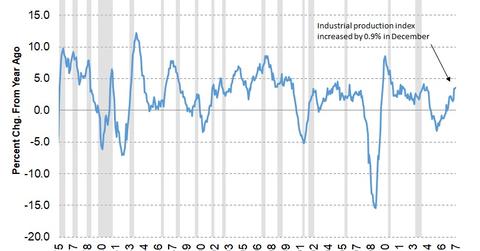What Drove Industrial Production Higher in December 2017
The Fed’s December industrial production report was released on January 17. The report indicated that industrial production continued to improve throughout 2017.
Jan. 26 2018, Updated 3:41 p.m. ET

Industrial production up 0.9%
The Fed’s December industrial production report was released on January 17. The report indicated that industrial production continued to improve throughout 2017, appreciating by 3.6% from 2016. In December, industrial production improved by 0.9% (month-over-month), beating the market expectation of 0.4% growth.
The Industrial Production Index tracks the performance of the manufacturing (XLI), gas, utilities (XLU), mining (XME), and electric sectors. Industrial production is a proven forward indicator, as improving industrial production indicates demand, job creation, and economic progress. Equity markets (SPY) respond positively to continued improvement in industrial production.
Key contributors to growth in 2017
December marked the fourth consecutive month of gains for the index, as industries continued to increase production. In 2017, the auto (CARZ) sector, which took the top spot in 2016, has given way to non-auto manufacturing sectors. Non-auto manufacturing improved production by 2.6% in 2017, whereas the auto sector saw 0.4% growth. The improvement in non-auto manufacturing signals that US industries are improving. The recent announcement of tariffs on washing machines and solar cells could be another boost to manufacturing. How long will the advantage sustain? Only time will tell.
Which sectors improved in December
According to the Fed’s report, the utilities sector’s output improved the most, by 15.6%, closely followed by the mining sector with a 1.6% improvement. All major sectors, barring the construction sector, reported marginal growth in output. In the next part of this series, we’ll analyze US industries’ changes in capacity utilization in December.
